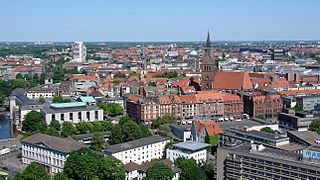
Hanover is the capital and largest city of the German state of Lower Saxony. Its 535,932 (2021) population makes it the 13th-largest city in Germany as well as the fourth-largest city in northern Germany after Berlin, Hamburg and Bremen. Hanover's urban area comprises the towns of Garbsen, Langenhagen and Laatzen and has a population of about 791,000 (2018). The Hanover Region has approximately 1.16 million inhabitants (2019) and is the largest in the Hanover–Braunschweig–Göttingen–Wolfsburg Metropolitan Region, the 17th biggest metropolitan area by GDP in the European Union.

Lower Saxony is a German state in northwestern Germany. It is the second-largest state by land area, with 47,614 km2 (18,384 sq mi), and fourth-largest in population among the 16 Länder federated as the Federal Republic of Germany. In rural areas, Northern Low Saxon and Saterland Frisian are still spoken, albeit in declining numbers.

The Georgengarten is a landscape garden in the northwestern borough of Herrenhausen of the German city Hanover. It is a part of Herrenhausen Gardens.
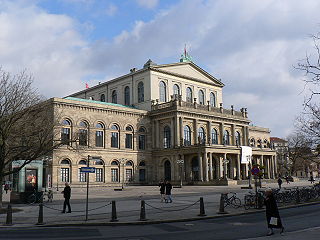
Hanover State Opera is a German opera company based in Hanover, the state capital of Lower Saxony. The company is resident in the Hanover Opera House, and is part of a publicly-funded umbrella performing arts organisation called Hanover State Theatre of Lower Saxony, or simply Hanover State Theatre.

The Herrenhausen Gardens of Herrenhausen Palace are located in Herrenhausen, an urban district of Hanover, the capital of Lower Saxony, Germany. Dating to the era of the Kings of Hanover, they comprise Great Garden, Hill Garden, Georgen Garden and Guelf Garden.
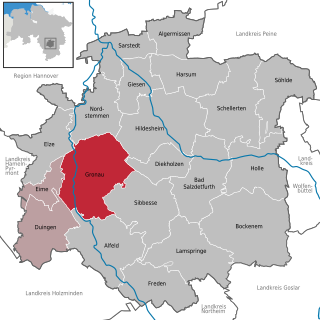
Gronau is a town and a municipality in the district of Hildesheim, in Lower Saxony, Germany. It is situated on the River Leine, approximately 15 km southwest of Hildesheim, and 35 km south of Hanover. Since 1 November 2016, the former municipalities Banteln, Betheln, Brüggen, Despetal and Rheden are part of the municipality Gronau.

Hannover Hauptbahnhof is the main railway station for the city of Hanover in Lower Saxony, Germany. The railway junction is one of the 21 stations listed as a railway Category 1 station by DB Station&Service. It is also the most important public transport hub of the region of Hanover and it is served regional and S-Bahn services. The station has six platforms with twelve platform tracks, and two through tracks without platforms. Every day it is used by 250,000 passengers and 622 trains stop at the platforms. About 2,000 people work here.

Rodenberg is a town in the district of Schaumburg, in Lower Saxony, Germany. It is situated on the northwestern edge of the Deister hills, approx. 10 km east of Stadthagen, and 27 km west of Hanover.

The New Town Hall is a town hall in Hanover, Germany. It opened on 20 June 1913 after construction lasting 12 years. A magnificent, castle-like building of the era of Wilhelm II in eclectic style at the southern edge of the inner city just outside the historic city centre of Hanover, the building is embedded within the 10-hectare (25-acre) Maschpark.

The Lower Saxon State Museum Hanover is the state museum of Lower Saxony in Hanover, Germany. Situated adjacent to the New Town Hall, the museum comprises the state gallery, featuring paintings and sculptures from the Middle Ages to the 20th century, and departments of archaeology, natural history and ethnology. The museum includes a vivarium with fish, amphibians, reptiles and arthropods.
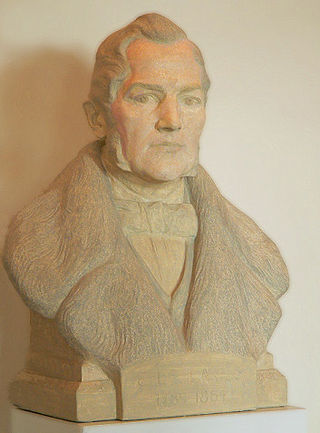
Georg Ludwig Friedrich Laves was a German architect, civil engineer and urban planner. Born in Uslar, Lower Saxony, he lived and worked primarily in the city of Hanover and also died there. He was appointed Oberhofbaudirektor, "court master builder", in 1852. As the leading architect of the Kingdom of Hanover for a career spanning 50 years, he had great influence on the urban development of this city. Alongside Karl Friedrich Schinkel in Berlin and Leo von Klenze in Munich, Laves was one of the most accomplished neoclassical style architects of Germany. As an engineer he developed a special iron truss lenticular or "fishbelly" beam bridge construction method, the so-called "Lavesbrücke". Laves found his final resting place in the Engesohde Cemetery in Hanover.

The Masch Lake is an artificial lake situated south of the city centre of Hanover, the capital of Lower Saxony, Germany. Covering an area of 78 hectares, it is the largest body of water within Hanover and a popular recreation area as well as venue for numerous water sports.

The Hill Garden is a historic botanical garden, one of the gardens of the Herrenhäuser Gärten, around the residence Herrenhäuser Schloss in Herrenhausen, now part of Hanover, Lower Saxony, Germany. The garden was first created in 1666 as a vegetable garden on a hill north of the palace, and then transformed into a garden for exotic plants. In 1750, it was developed into a botanical garden, with some unusual trees from the period still surviving. It features a palm house, first built in 1846, and a mausoleum, where members of the royal family were interred. Damaged by air raids in World War II, the gardens were restored. In 2000, a house for rain forest-themed gardens was added, which was transformed to an aquarium in 2007.

The Red Thread is a 4.2-kilometre (2.6 mi) urban walking trail in Hanover, Germany, to 36 significant points of interest about architecture and the history of the city centre.
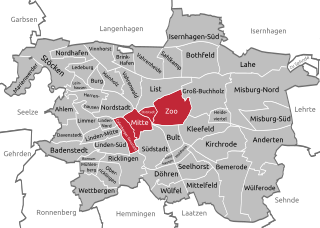
Mitte is the first borough of Hanover, the state capital of Lower Saxony. As of 2020, it has 36,645 inhabitants and consists of the quarters Mitte, Calenberger Neustadt, Oststadt and Zoo. The district mayor is Cornelia Kupsch (CDU).
The following is a timeline of the history of the city of Hanover, Germany.

Aegidien Church, after Saint Giles to whom the church was dedicated, is a war memorial in Hanover, the capital of Lower Saxony, Germany. The church dates from 1347, when it replaced an older Romanesque church dating to 1163. This in turn replaced an even earlier chapel. Aegidien Church was destroyed during the night beginning 8 October 1943 by aerial bombings of Hanover during World War II. In 1952, Aegidien Church became a war memorial dedicated to victims of war and of violence.

The Old Town Hall is a former, and the first, town hall in Hanover, Germany. Originally built in the old city district in 1410, replaced by the New Town Hall in 1913, and extensively restored in 1953 and 1964 after heavy bomb damage in World War II, it is the oldest secular building in the city. The market façade with the highly sophisticated Brick Gothic of the lucarnes has been preserved and partly restored in its medieval shape. Some elements of it were copied on other wings of the building.
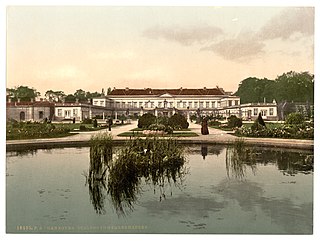
Herrenhausen Palace is a former royal summer residence of the House of Hanover in the Herrenhausen district of the German city of Hanover. It is the centrepiece of Herrenhausen Gardens. Sophia of Hanover oversaw the development of the estate in the late 1600s.
The Hanover Monastic Chamber, based in Hanover, is a special authority within the scope of the Ministry of Science and Culture of Lower Saxony. It administers former ecclesiastical, mediatized property and maintains churches and convents. In addition, as a foundation body, it administers four independent foundations under public law.






















